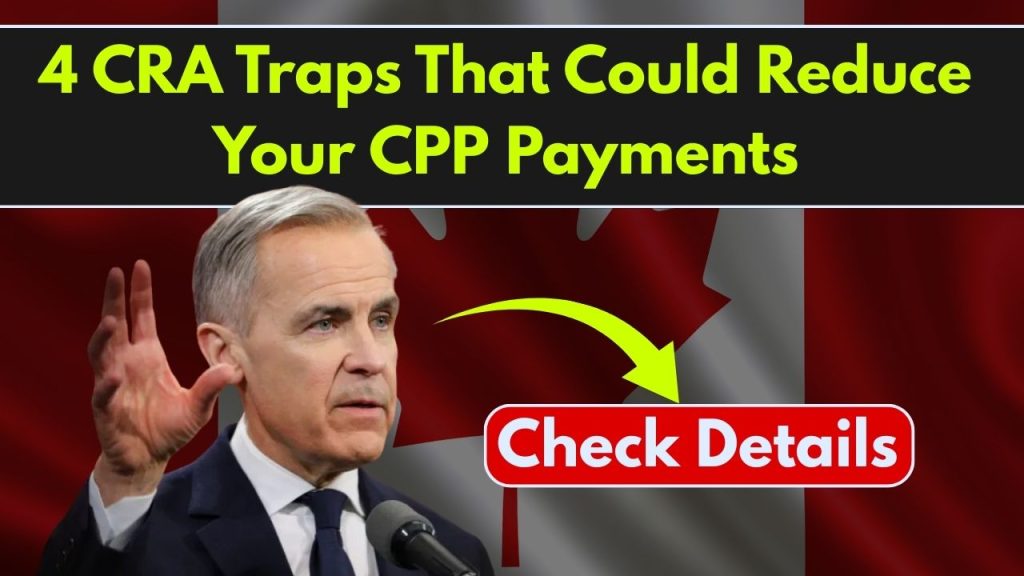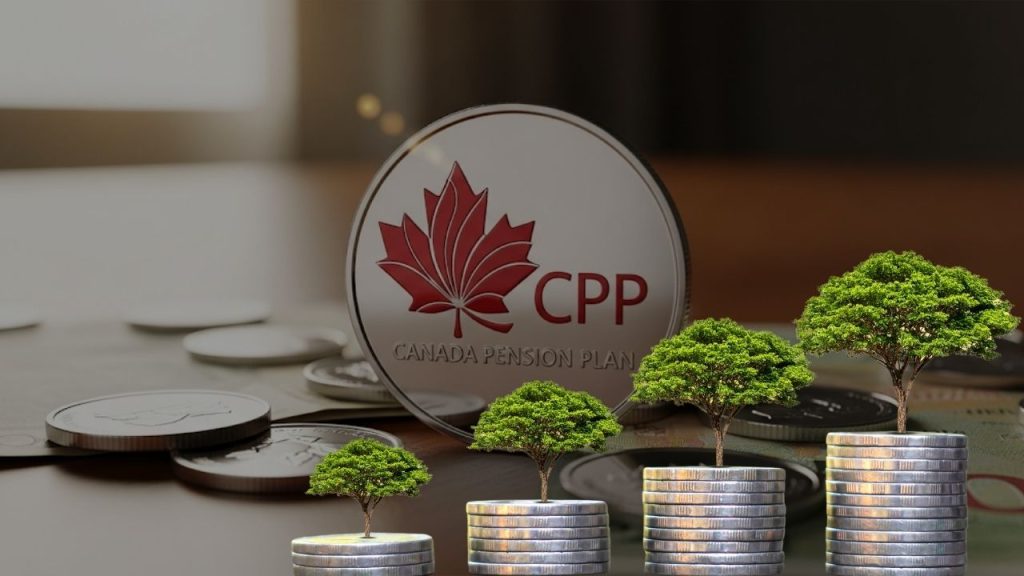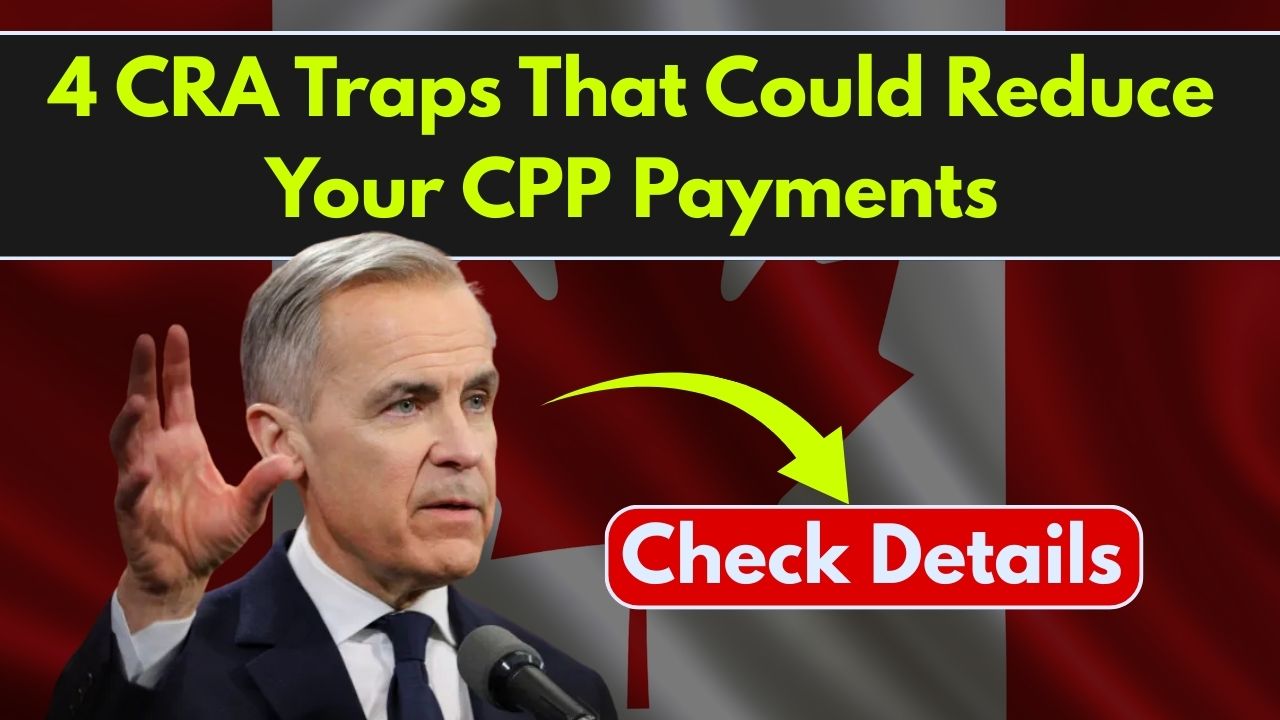If you’re a Canadian planning for retirement, it’s important to understand how your Canada Pension Plan (CPP) payments are calculated and what Canada Revenue Agency (CRA) traps could reduce your benefits. The CRA sets specific rules that impact the size of your CPP payments, and without the right knowledge, you could end up with a significantly smaller monthly pension than you expect.

In this article, we will explain in clear, easy-to-understand terms the four main CRA traps that could lower your CPP payments, why they matter, and what you can do to avoid them. Whether you are starting your career or approaching retirement, knowing these traps will help you keep more of your hard-earned money in the future.
4 CRA Traps That Could Reduce Your CPP Payments
| Topic | Details |
|---|---|
| Maximum CPP Payment 2025 | $2,034.86 per month (if claimed at age 70) |
| CPP Reduction for Early Collection | 0.6% t reduction per month before age 65 (36% total if claimed at 60) |
| Income Threshold for OAS Clawback | $93,454 for 2025 |
| Yearly Maximum Pensionable Earnings (YMPE) 2025 | $71,300 |
| Additional Maximum Pensionable Earnings (YAMPE) 2025 | $81,200 |
| Official CPP Information | Canada Pension Plan – CRA |
Understanding the four common CRA traps that can reduce your CPP payments is crucial for retirement planning in 2025. Low pensionable earnings, early CPP collection, taxation of CPP benefits, and the OAS clawback threshold can all reduce your retirement income if unaddressed.
By planning your pensionable earnings, timing your CPP claims wisely, and employing tax-efficient strategies including TFSA use, you can protect and enhance your retirement benefits. Early and informed planning will ensure that your CPP remains a valuable foundation for your retirement security.
What is the Canada Pension Plan (CPP)?
The Canada Pension Plan is a government program designed to provide Canadians with a basic income during retirement. It replaces a portion of your earnings after you retire, helping you pay for essentials like food, medicine, and housing. Every Canadian who works and contributes to CPP builds up credit toward their retirement benefits.
You can start collecting CPP as early as age 60 or delay it until age 70. Your monthly payment depends on how much and how long you contributed during your working years, and when you decide to begin collecting.
Four CRA Traps That Can Reduce Your CPP Payments
1. Low or Non-Pensionable Earnings
CPP contributions are based on pensionable earnings, which include salaries or business income but exclude investment income like dividends. This means income from dividends or capital gains does not count toward CPP contributions.
For example, many small business owners pay themselves through dividends rather than salaries because dividends have favorable tax treatment. However, dividends do not count as pensionable earnings, so you contribute less to CPP and end up receiving lower CPP benefits.
In 2025, the Yearly Maximum Pensionable Earnings (YMPE) is $71,300. Income below this amount is subject to CPP contributions. There is also an additional maximum pensionable earnings (YAMPE) threshold at $81,200 for calculating extra contributions under the CPP enhancement.
2. Collecting CPP Early (Starting at Age 60)
You might think starting CPP at the earliest possible age helps, but claiming CPP early permanently reduces your payments. Specifically, your monthly payment is reduced by 0.6% for each month you claim before age 65, adding up to a 36% reduction at age 60.
If you can wait until age 65, you get the full CPP payment based on your contributions. Beyond age 65, the CPP increases by 0.7% for each month you delay, up to age 70, potentially increasing your payment by 42%.
While many Canadians claim CPP as early as 60 due to immediate financial needs, health concerns, or job loss, waiting can make a big difference in your overall retirement funds.
3. CPP Payments Are Taxable Income
Even though CPP provides income during retirement, it is considered taxable income. If your career earnings were high (especially close to or above the YMPE and YAMPE), your CPP payout can push you into a higher tax bracket during retirement.
For instance, the maximum CPP payment in 2025 is $2,034.86 per month if claimed at age 70, but that is the gross amount before taxes.
Without planning, you may find a significant portion of your CPP payments taxed away. Smart tax planning strategies can help limit the amount of tax you pay on your pension income.
4. Old Age Security (OAS) Clawback Due to High Income
Another way your retirement income can be reduced indirectly is through the Old Age Security (OAS) clawback. If your total income (including CPP, other pensions, and earnings) exceeds $93,454 in 2025, the government reduces or “claws back” part of your OAS payments.
If you receive maximum CPP benefits, your total income might push you above this threshold, resulting in less OAS income and therefore reducing your overall retirement income.
Being aware of this clawback helps you plan your income for tax efficiency and maximum benefits.

How to Avoid These CRA Traps and Maximize Your CPP
Maximize Your Pensionable Earnings
- Aim to have a large portion of your income as salary or business income to maximize CPP contributions.
- If you own a business, carefully balance dividends and salary to optimize both taxes and CPP contributions.
Choose the Right Age to Start CPP
- Consider waiting until age 65 or later to start collecting CPP for higher monthly payments.
- Understand the consequences of early collection—especially the permanent reduction of up to 36% if you claim at 60.
Plan Your Taxes on CPP Income
- Work with a tax professional to employ strategies like income splitting or using tax-advantaged accounts.
- Consider investments that produce tax-free income to reduce your taxable retirement income.
Manage Income to Avoid OAS Clawback
- Keep your income below the OAS clawback threshold by diversifying income sources.
- Use Tax-Free Savings Accounts (TFSA) to generate tax-free income that does not affect your OAS benefits.
TFSA: A Tax-Free Way to Supplement Your Retirement Income
A TFSA is a powerful tool for supplementing retirement income while minimizing taxes:
- Contributions grow tax-free, and withdrawals are not counted as taxable income.
- TFSA income does not impact OAS clawback calculations.
- You can withdraw TFSA funds at any age without penalty.
- Ideal for holding dividends, interest, or capital gains to provide tax-free income.
Starting early on building a TFSA with investments that generate passive income can significantly increase your retirement savings.
3 New CRA Benefit Payments Coming to Ontario in August 2025 — See If You Qualify
Canada Parents Alert: Up to $666 per Child Arriving August 20!
New Cheques Are Coming in August and September Across Canada — Are You on the List?
FAQs About 4 CRA Traps That Could Reduce Your CPP Payments
When is the best age to start collecting CPP?
Age 65 is generally the best balance, but delaying until age 70 increases your payments by up to 42%. Starting at 60 reduces payments by 36% permanently.
How much can I contribute to CPP in 2025?
In 2025, CPP contributions apply to earnings up to $71,300 plus additional contributions on earnings up to $81,200 under the enhanced plan.
Are CPP payments taxable?
Yes, CPP payments are considered taxable income and can affect your overall tax bracket in retirement.
What is the OAS clawback?
The OAS clawback reduces OAS payments when your income exceeds $93,454, impacting your total retirement income if your CPP and other earnings are high.
How can I avoid losing retirement income due to taxes and clawbacks?
Use income-splitting, tax planning, and tax-free accounts like TFSA to keep more of your retirement money.





